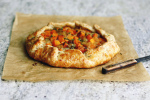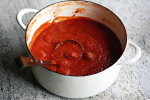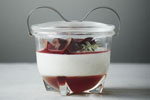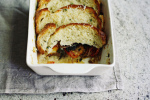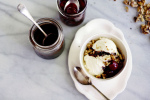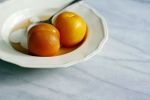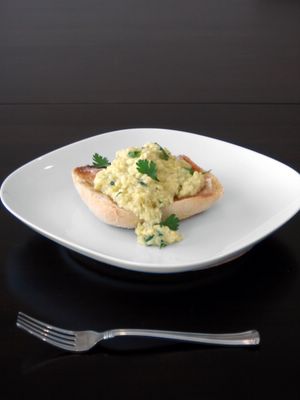
As I was discussing with a friend recently, fall has a very specific personality to it. While I love summer for all its brightness and enthusiasm, this time of year seems bring along a sense of hospitality. The market is still filled with colour, albeit from a kaleidoscope of rainbow hues to a wash of sunset shades. Now is the time to start braising meats and revisiting classic cold-weather comfort food. It is this idea of hearth and home, of generosity and bounty, that truly makes autumn my favourite season.
It was with this thought in mind that I started thinking about what to do with the apples I had from Schouwenaar Orchards and Vineyards. It was the weekend after the official start to fall, and I was looking for something that was homey and comforting. As I padded through the house in my slippers and robe, my gaze fell across the most recent edition of Everyday Food Magazine. Curled up to our breakfast counter, perched on a stool and with hands wrapped firmly around a warm mug, I flipped through the pages until I came upon an in-depth article on apples — with recipes both savoury and sweet, including one for an applesauce cake.
Remembering a favourite recipe for homemade applesauce using apple cider, I switched my mug for a peeler and started to work. Using a mix of Redcort, McIntosh and Galas, I happily worked away, and soon the kitchen was filled with the smells of mulled spices and the cooking fruit. What a perfect way to start a Saturday.
Once it had cooled I was left with a slightly tart, but sweetly balanced, sauce. With this success boosting my confidence, I turned to the cake recipe. As I’ve mentioned before, I'm not one to leave well enough alone — so I gave into my need to fiddle and started scribbling notes.
I had just received the thoughtful gift of miniature tube pans from my mother, so they had to be used, no doubt about it. The magazine called for light brown sugar only, but instead I included a bit of Demerara sugar, wanting the depth of almost burnt sweetness it brings. I also omitted the cardamom, as my cider applesauce was highly spiced. In one batch, I switched out the honey for maple syrup, for no other reason that I thought the spicy caramel taste would bring another note to compliment the apples.
Apple cider applesauce
Well-flavoured and slightly tangy, this is a great simple applesauce to use alone or in cooking. It has more character than store bought varieties, and comes together quite quickly. As an added bonus, your kitchen will smell heavenly as it cooks. You can use a mulled cider for this recipe, but may want to omit the cinnamon called for.
3 pounds apples, peeled, cored and cut into ½” slices (or thereabouts)
1 cinnamon stick or ½ teaspoon ground cinnamon
1 cup apple cider
2 teaspoons freshly squeezed lemon juice
Honey (optional)
In a large saucepan, combine apples, cinnamon and cider and bring to a boil. Cover and reduce heat, let simmer for 40 minutes, stirring occasionally. If the sauce looks too dry at any time, add a few tablespoons of water.
When apples are tender, remove from heat and discard cinnamon stick (if using). Stir in lemon juice, and check for sweetness. If needed, add honey to taste, to balance flavours.
Makes approximately 4 cups.
Notes
• Sugar can be used instead of the honey, but should then be added before the apples are fully cooled so that it can dissolve. I find honey a much more mellow sweet, and enjoy the resiny depth it adds.
Applesauce Cake
Inspired by the recipe published in Everyday Food.
Non-stick cooking spray
3 cups all-purpose flour (spooned and levelled)
2 teaspoons baking soda
1 teaspoon salt
1 ½ teaspoons ground cinnamon (you may omit this if you used a heavily-mulled cider in the applesauce)
1 cup unsalted butter, softened
1 ½ cups packed light brown sugar
½ cup Demerara sugar
¼ cup maple syrup or honey
2 large eggs
2 cups apple cider applesauce (or store-bought)
Icing/confectioner’s sugar (optional)
Preheat oven to 175° C (350°F).
Generously coat twelve 1 cup capacity miniature tube pans (usually in available in sheets of six), or a 10 inch tube pan.
In a large bowl, sift together flour, baking soda, salt and cinnamon.
In the bowl of an electric mixer (or using a handheld), beat together butter, brown sugars and maple syrup/honey until light and fluffy. Add eggs, one at a time, beating until well combined. The mixture should be pale and airy. With mixer on low, gradually add spoonfuls of the flour mixture, mixing until just combined. Beat in applesauce.
Spoon batter into prepared pans, smoothing the tops. Bake until a toothpick or cake tester comes out mostly clean (slightly wet) when inserted in the middle of the cake, 12-18 minutes with the miniature pans, or 50-60 using a traditional tube pan. Be sure not to over bake.
Cool in pan on a wire rack for 10 minutes. Invert onto a cutting board or baking sheet, and then again onto rack, top side up. Allow to cool completely. Serve either top or bottom side up (I liked the bottoms), with a light dusting of icing sugar.
Notes:
• Can be served alone, or with a scoop of cinnamon ice cream or a dollop of maple whipped cream.
• This cake keeps well, wrapped in the fridge. The flavours will mellow and blend.
• This batter is also good when baked in muffin tins - served with a bit of sweet butter, they make a lovely snack or breakfast.
 Tuesday, October 11, 2005 at 11:48AM
Tuesday, October 11, 2005 at 11:48AM 

